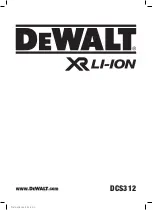
-34-
Model W1878 (For Machines Mfd. Since 4/21)
O
PE
R
ATIO
NS
•
Raker
: Considered to be the standard because the
tooth size and shape are the same as the tooth
gullet. The teeth on raker blades usually are very
numerous, have no angle, and produce cuts by
scraping the material. As a result, smooth cuts can
be achieved without cutting fast or generating more
heat than other tooth types.
•
Skip
: Similar to a raker blade that is missing every
other tooth. Because of the design, skip toothed
blades have a much larger gullet than raker blades,
and therefore, cut faster and generate less heat.
However, these blades also leave a rougher cut than
raker blades.
•
Hook
: The teeth have a positive angle (downward)
which makes them dig into the material, and the
gullets are usually rounded for easier waste removal.
These blades are excellent for the tough demands of
resawing and ripping thick material.
Raker
Skip
Hook
Figure.38.
Main blade tooth styles.
Tooth.Pitch
Measured as TPI (teeth per inch), tooth pitch determines
the number of teeth. More teeth per inch (fine pitch)
will cut slower, but smoother; while fewer teeth per inch
(coarse pitch) will cut rougher, but faster. As a general
rule, choose blades that will have at least three teeth
in the material at all times. Use fine-pitched blades on
harder woods and coarse-pitched blades on softer woods.
Blade.Care
A bandsaw blade is a thin piece of steel that is subjected
to tremendous stresses when cutting. You can obtain
longer use from a bandsaw blade if you give it fair
treatment and always use the appropriate feed rate for
your operation. Be sure to select blades with the proper
width, style, and pitch for each application. The wrong
choice of blades will often produce unnecessary heat
which will shorten the life of your blade.
A clean blade will perform much better than a dirty blade.
Dirty or gummed up blades pass through the cutting
material with much more resistance than clean blades.
This extra resistance also causes unnecessary heat. Resin/
pitch cleaners are excellent for cleaning dirty blades.
Tooth.Style
Figure.38
illustrates the three main blade tooth styles:
Blade.Breakage
Many conditions may cause a bandsaw
blade to break. Blade breakage is
unavoidable, in some cases, since it is
the natural result of the peculiar stresses
that bandsaw blades are subjected to.
Blade breakage is also due to avoidable
circumstances. Avoidable breakage is most
often the result of poor care or judgement
on the part of the operator when mounting
or adjusting the blade or blade guides.
The.most.common.causes.of.blade.
breakage.are:
• Faulty alignment/adjustment of the
guides.
• Forcing/twisting a wide blade around
a short radius.
• Feeding the workpiece too fast.
• Dull teeth or damaged tooth set.
• Over-tensioned blade.
• Upper blade guide assembly set too
high above the workpiece.
• Using a blade with a lumpy or
improperly finished braze or weld.
• Continuously running the bandsaw
when not in use.
• Leaving blade tensioned when not in
use.
• Using the wrong TPI for the workpiece
thickness. (The general rule of thumb
is three teeth in the workpiece at all
times.)
Содержание W1878
Страница 60: ......
















































